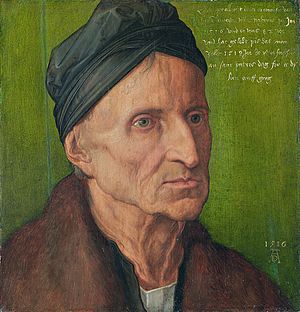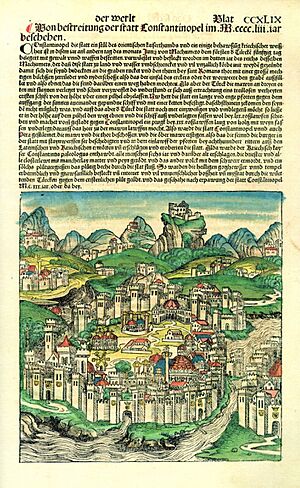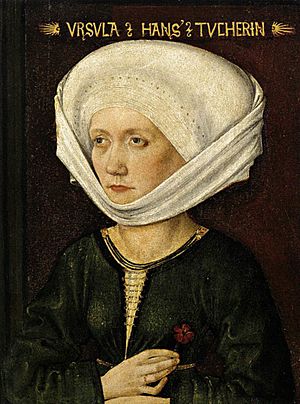Michael Wolgemut facts for kids
Quick facts for kids
Michael Wolgemut
|
|
|---|---|

Portrait of Michael Wolgemut by Albrecht Dürer, around 1516.
|
|
| Born | 1434 Nuremberg, Holy Roman Empire |
| Died | 30 November 1519 (aged 85) |
| Resting place | Nuremberg |
| Occupation | Painter and printmaker. |
| Spouse | Hans Pleydenwurff's widow |
| Children | Wilhelm Pleydenwurff |
Michael Wolgemut (born in 1434, died November 30, 1519) was an important German artist. He was a talented painter and a printmaker, which means he created pictures by carving designs into wood or metal to print them.
Wolgemut ran a busy art workshop in Nuremberg, a city in Germany. He is most famous for being the teacher of a very well-known artist named Albrecht Dürer. Dürer learned a lot from Wolgemut between 1486 and 1489.
Wolgemut's workshop was a big deal. Many young artists worked there as assistants and learned different art skills. They made large paintings for churches, like altarpieces. They also created beautiful carved wooden altars, which were often decorated with gold and bright colors.
Wolgemut was also a leader in making better woodcuts. Woodcuts are prints made from carved wooden blocks. His workshop made many woodcuts for books, especially for publishers in Nuremberg. These woodcuts were often hand-colored. Wolgemut's prints showed more depth and shading than before, making them look more realistic.
His paintings often showed influences from Flanders (an area that is now part of Belgium). This suggests he might have traveled there.
Contents
Michael Wolgemut's Life Story
Michael Wolgemut learned art from his father, Valentin Wolgemut. His father passed away around 1469 or 1470. Michael then worked as an assistant for another artist named Hans Pleydenwurff in Nuremberg.
In 1471, he worked in Munich for a short time. After a disagreement about a broken engagement, he returned to Nuremberg. He took over his late father's workshop, which his mother had been managing.
In 1472, Michael Wolgemut married Hans Pleydenwurff's widow. This meant he also took over Hans's workshop. Her son, Wilhelm Pleydenwurff, became Michael's assistant. Later, in 1491, Wilhelm became Michael's partner. Some people think Wilhelm was an even better artist than Wolgemut, but he died young in 1494.
Amazing Woodcuts for Books
Wolgemut and his stepson Wilhelm Pleydenwurff created woodcuts for two very important books. These books were printed by Anton Koberger, who was a big publisher in Nuremberg and also Dürer's godfather.
One of these books was called Schatzbehalter der wahren Reichthumer des Heils (1491). The other was the Historia mundi (1493), also known as the Nuremberg Chronicle. This book is famous for its amazing 1,809 illustrations, not just its text.

Wolgemut and Wilhelm Pleydenwurff started working on the illustrations for the Nuremberg Chronicle in 1487. A drawing by Wolgemut for the book's detailed front page, made in 1490, is now in the British Museum. Many of the woodcuts in the book, like those showing towns, battles, or kings, were used more than once. Only the text labels were changed. The book was very large, with some woodcuts covering two pages.
Famous Paintings
Wolgemut's earliest known painting is an altarpiece from 1465. It has four panels and is now in a gallery in Munich. In 1479, he painted a large altarpiece for a church in Zwickau, for which he received a lot of money.
One of his biggest and best works is a large altarpiece he painted for the Augustinian friars' church in Nuremberg. It has many panels showing figures of saints who were important in that area. This altarpiece is now in a museum.
In 1501, Wolgemut was hired to decorate the town hall in Goslar. He painted many pictures there, some on the ceiling and others on the walls using a thin paint called tempera on canvas. He was also known for his portraits, which were very realistic and detailed.
Not many of Wolgemut's paintings are found outside Germany. The Royal Institution in Liverpool has two good examples: Pilate washing his Hands and The Deposition from the Cross. These were probably parts of a larger altarpiece.
During the last ten years of his life, Wolgemut didn't paint as much himself. One of his last paintings is an altarpiece in Schwabach, finished in 1508. He died in Nuremberg in 1519.
Images for kids
See also
 In Spanish: Michael Wolgemut para niños
In Spanish: Michael Wolgemut para niños






